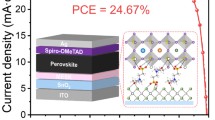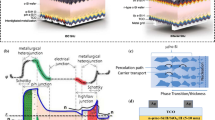Abstract
A simple, low-cost, post-black etching process atop the random pyramidal emitter has been proposed and investigated. The multi-scale texture is achieved by combining nanoporous layer formed by the post-black etching with micron-scale pyramid texture. Compared to the pre-black etched Si solar cells, our experiments clearly show the advantage of post-black etched texturing: it enables high blue response and improved conversion efficiency. As a result, the enhancement of 7.1 mA/cm2 on the short-circuit current density and improvement of 31 % in the conversion efficiency have been reached.





Similar content being viewed by others
References
H.M. Branz, V.E. Yost, S. Ward, K.M. Jones, B. To, P. Stradins, Nanostructured black silicon and the optical reflectance of graded-density surfaces. Appl. Phys. Lett. 94, 231121 (2009)
Y. Wang, Y.P. Liu, H.L. Liang, Z.X. Mei, X.L. Du, Broadband antireflection on the silicon surface realized by Ag nanoparticle-patterned black silicon. Phys. Chem. Chem. Phys. 15, 2345–2350 (2013)
Dinesh Kumar, Sanjay K. Srivastava, P.K. Singh, M. Husain, Vikram Kumar, Fabrication of silicon nanowire arrays based solar cell with improved performance, Sol. Energy. Mater. Sol. Cells 95 (2011) 215–218
M. Saadoun, H. Ezzaouia, B. Bessams, M.F. Boujmil, R. Bennaceur, Formation of porous silicon for large-area silicon solar cells: a new method. Sol. Energy Mater. Sol. Cells 59, 377–385 (1999)
E.A. Petrova, K.N. Bogoslovskaya, L.A. Balagurov, G.I. Kochoradze, Room temperature oxidation of porous silicon in air. Mater. Sci. Eng. B 69–70, 152–156 (2000)
V.V. Iyengar, B.K. Nayak, M.C. Gupta, Optical properties of silicon light trapping structures for photovoltaics. Sol. Energy Mater. Sol. Cells 94, 2251–2257 (2010)
S.K. Srivastava, D. Kumar, Vandana, M. Sharma, R. Kumar, P.K. Singh, Silver catalyzed nano-texturing of silicon surfaces for solar cell applications. Sol. Energy. Mater. Sol. Cells 100 (2012) 33–38
P. Saring, A.L. Baumann, B. Schlieper-Ludewig, P. Saring, S. Kontermann, W. Schade, M. Seibt, Electronic and structural properties of femtosecond laser sulfur hyperdoped silicon pn-junctions. Appl. Phys. Lett. 103, 061904 (2013)
M. Otto, M. Kroll, T. Käsebier, R. Salzer, A. Tünnermann, R.B. Wehrspohn, Extremely low surface recombination velocities in black silicon passivated by atomic layer deposition. Appl. Phys. Lett. 100, 191603 (2012)
Tsing-Hua Her, Richard J. Finlay, Wu Claudia, Shrenik Deliwala, Mazur, Microstructuring of silicon with femtosecond laser pulses. Appl. Phys. Lett. 73, 1673 (1998)
S.K. Srivastava, D. Kumar, Vandana, M. Sharma, R.Kumar, P.K. Singh, Silver catalyzed nano-texturing of silicon surfaces for solar cell applications. Sol. Energy Mater. Sol. Cells. 100 (2012) 33-38
B. Dou, R. Jia, H. Li, C. Chen, Y. Sun, Y. Zhang, W. Ding, Y. Meng, X. Liu, T. Ye, Fabrication of ultra-small texture arrays on multicrystalline silicon surface for solar cell application. Sol. Energy 91, 145–151 (2013)
K. Peng, Y. Xu, Y. Wu, Y. Yan, S.-T. Lee, J. Zhu, Aligned single-crystalline Si nanowire arrays for photovoltaic applications. Small 1 (2005) 1062
Y. Jiang, R. Qing, H. Yang, C. Chen, H. Ma, F. Chang, Alkali-treated Si nanowire array for improving solar cell performance. Appl. Phys. A 113, 13–17 (2013)
O. Jihun, H.-C. Yuan, H.M. Branz, An 18.2 %-efficient black-silicon solar cell achieved through control of carrier recombination in nanostructures. Nat. Nanotechnol. 7, 743–748 (2012)
J. Yoo, Y. Gwonjong, Y. Junsin, Black surface structures for crystalline silicon solar cells. Mater. Sci. Eng., B 159–160, 333–337 (2009)
J.S. Yoo, I.O. Parm, U. Gangopadhyay, K. Kim, S.K. Dhungel, D. Mangalaraj, J. Yi, Black silicon layer formation for application in solar cells. Sol. Energy Mater. Sol. Cells. 90, 3085–3093 (2006)
W.C. Hsu, Y.S. Lu, J.Y. Chyan, J.A. Yeh, High-efficiency 6″ multicrystalline black solar cells based on metal-nanoparticle-assisted chemical etching. Int. J. Photoenergy 2012, 197514 (2012)
In-Ji Lee, Ungyu Paik, Jea-Gun Park, Solar cell implemented with silicon nanowires on pyramid-texture silicon surface. Sol. Energy 91, 256–262 (2013)
J. Liu, M. Ashmkhan, G. Dong, B. Wang, F. Yi, Fabrication of micro-nano surface texture by CsCl lithography with antireflection and photoelectronic properties for solar cells. Sol. Energy Mater. Sol. Cells 108, 93–97 (2013)
B.S. Kim, D.H. Lee, J.S. Hee Kim, G.-H. An, K.-J. Lee, N.V. Myung, Y.-H. Choa, Silicon solar cell with nanoporous structure formed on a textured surface. J. Am. Ceram. Soc. 92, 2415–2417 (2009)
F. Toor, H.M. Branz, M.R. Page, K.M. Jones, H.-C. Yuan, Multi-scale surface texture to improve blue response of nanoporous black silicon solar cells. Appl. Phys. Lett. 99, 103501 (2011)
Z. Shen, B. Liu, Y. Xia, J. Liu, J. Liu, S. Zhong, C. Li, Black silicon on emitter diminishes the lateral electric field and enhances the blue response of a solar cell by optimizing depletion region uniformity. Scripta Mater. 68, 199–202 (2013)
B.R. Mohamed, H. Anouar, B. Brahim, Improvement of multicrystalline silicon solar cell performance via chemical vapor etching method-based porous silicon nanostructures. Solar Energy. 86, 1411–1415 (2012)
K.-Q. Peng, Y.-J. Yan, S.-P. Gao, J. Zhu, Synthesis of large-area silicon nanowire arrays via self-assembling nanoelectrochemistry. Adv. Mater. 14, 1164–1167 (2002)
V. Lehmann, H. Föll, Formation mechanism and properties of electrochemically etched trenches in n-type silicon. J. Electrochem. Soc. 137, 653–659 (1990)
D. Kumar, S.K. Srivastava, P.K. Singh, M. Husain, V. Kumar, Fabrication of silicon nanowire arrays based solar cell with improved performance. Solar Energy Mater. Solar Cells 95, 215–221 (2011)
Acknowledgments
This work is supported by Chinese Nature Science Foundation Committee (No. 11074066) and Henan Provincial Basic and Frontier Project (No. 132300410248).
Author information
Authors and Affiliations
Corresponding authors
Rights and permissions
About this article
Cite this article
Jiang, Y., Yang, H., Cao, W. et al. Post-black etching on emitter to improve performance of multi-scale texture silicon solar cells. Appl. Phys. A 116, 1409–1414 (2014). https://doi.org/10.1007/s00339-014-8247-0
Received:
Accepted:
Published:
Issue Date:
DOI: https://doi.org/10.1007/s00339-014-8247-0




